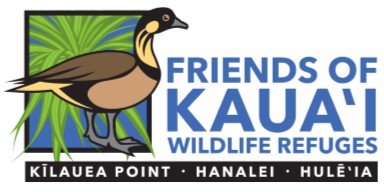Wildlife Spotlight: koaʻe ʻula
In February, the koaʻe ʻula, or red-tailed tropicbirds, returned to the Hawaiian Islands to nest and can be seen at Kīlauea Point NWR through late October. In Hawaiian ʻŌlelo, many of the wildlife species were either named for the sound they make or for a physical characteristic. Koa‘e refers to tropicbirds and ‘ula means red.
Mature koaʻe ʻula have mostly white plumage with a conspicuous black stripe from the gape, curving towards and passing through the eye, and a deep red to orange-red beak. They have a long red tail feather that can reach nearly two feet in length, which gives the bird its name. These tail feathers were used to create kāhili, which are Hawaiian standards indicative of royalty and used in ceremony.
Kīlauea Point NWR is a great place to view koaʻe ʻula. They can be seen performing complex aerial courtship behavior, which includes dramatic vertical displays, and flying in circles and even backwards!
Koaʻe ʻula begin breeding after 4 years of age and their peak nesting activity is from March through August each year. Adults generally return to the same nest site each year, which are usually located in sheltered areas from the sun, such as at the base of a tree, in shrubs, or next to a structure.
Koaʻe ʻula are pelagic birds, meaning they spend the majority of their life on the open ocean and only venture back to land to breed. They are powerful fliers with exceptionally long, thin wings, and can remain in flight for days or weeks at a time, sleeping mid-flight, while staying hundreds to thousands of miles offshore. Like other seabirds, they have a special salt gland that helps them extract excess salt from their body. This allows them to drink seawater and ingest water from prey without accumulating toxic levels of salt in their bloodstream.
The female will lay a single egg, ranging in color from brown to purplish black. However, unlike most other seabirds, relaying (or laying a second egg) can occur if the first egg is lost or infertile. The incubation period varies from 39-51 days and both parents will incubate the egg. Average incubation shifts range from 8-9 days, while the mate is out at sea.
During the first few weeks after hatching, chicks are attended to and fed by one of its parents in shifts, similar to those during incubation. The chick-rearing period can range from 77 to 123 days and chicks reach adult weight within six weeks. At 11 weeks, wing exercising begins and in 12-13 weeks, fledging occurs – generally throughout the summer months. Chicks will fledge with a dark gray bill and white and gray plumage and will join the adult koaʻe ʻula as they travel across vast expanses of the subtropical Indian and Pacific Oceans before returning to their original nest site to repeat the cycle.
Photo Credit: Hob Osterlund, USFWS


